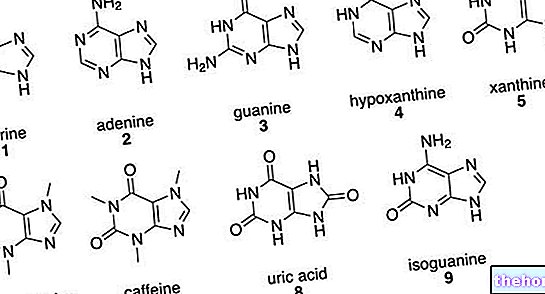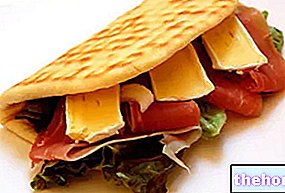Generality
For hard-boiled eggs we mean a culinary preparation based on hen's eggs, cooked whole in their shells and in cold water *, and characterized by the solidity of both the albumen and the yolk with overall preservation of the original shape.

The preparation of hard-boiled eggs is quite simple and the procedure could be summarized as follows: fill a pan with cold water, place the whole (medium) eggs in it, put the pan on the stove over high heat and bring to a boil, keeping it for 8-10 " (not more); drain, taking care not to break the hard-boiled eggs, cool them in fresh water, then remove their shells.
Why is it necessary to cook eggs in cold and not hot water?
Hard-boiled eggs must be cooked in cold water since the "thermal shock" of the boiling hot water causes, most of the time, the breaking of the shell and the deformation of the hard-boiled eggs due to the escape of the albumen.
Why should the cooking time of hard-boiled eggs not last beyond 10 "?
The overcooking of hard-boiled eggs causes a chromatic mutation caused by the chemical interaction of its elements; in practice, the yolk of overcooked hard-boiled eggs "darkens" on the surface acquiring a greenish color. The longer the cooking is continued, the more the yolk of hard-boiled eggs acquires a dark green color.
Does the change in color of the yolk indicate the toxicity of hard-boiled eggs?
No. This chemical reaction occurs following excessive exposure of hard-boiled eggs to heat and the only side effect is a reduction in the bio-availability of the iron contained in the yolk. In short: it happens that the sulfur complexes of the inner region of the albumen (hydrogen sulfide) undergo degradation releasing the sulfur; the latter, being reactive, binds the iron of the external region of the yolk giving rise to a black complex (ferrous sulphide). The dark reflections of this compound, in contrast with the yellow of the yolk, determine the green color. The toxicity of ferrous sulphide is no higher than that of the original hydrogen sulphide.
How do you peel hard-boiled eggs?
Hard-boiled eggs, to be peeled in a simple and effective way, must be immediately cooled in water; skipping this step it is possible that the egg white remains adherent to the shell breaking when it is separated. To separate the shell it is then necessary to crack it by tapping it with a spoon or by beating the hard-boiled eggs gently on a solid surface.
Boiled Eggs - All the Tricks to Cook Them Perfectly
Problems with playing the video? Reload the video from youtube.
- Go to the Video Page
- Go to the Video Recipes Section
- Watch the video on youtube
Nutritional characteristics
Cooking in cold water is, after soft-boiled and poached, the most digestible method of cooking eggs.
When subjected to excessive heat treatment, in addition to acquiring an unpleasant pigmentation and undergoing a nutritional curtailment (chelation of iron in the ferrous sulphide and degradation of thermolabile vitamins), hard-boiled eggs also become (slightly) less digestible; however, it is sufficient to remember to NEVER extend cooking beyond 10 "from the moment of boiling: in this way the preparation will always be of the highest quality.
NB. I suggest to carry out several tests, gradually reducing the cooking by 1 "or 30" ". This is justified by the fact that each method is essentially different from the other; the most important variables are: volume of water, size-shape and type of pot, intensity of the heat source and use or not of the lid. It is NOT possible to use the microwave oven which causes the boiled eggs to explode.

Nutritional values (per 100 g of edible portion)
The nutritional composition of hard-boiled eggs is almost comparable to that of raw egg; the substantial differences are:
- Reduction of thermolabile vitamin concentration
- Increased availability of biotin (vit. H) by degradation of the chelating protein greedy
- Increased / decreased protein digestibility (EXTREMELY VARIABLE based on the "hand" of the operator) *
* An egg brought to a slightly firm consistency is more digestible than raw egg, while an over-boiled hard-boiled egg (≥15 "from the moment of boiling) undergoes a recombination of protein structures such as to worsen digestibility (similar to meat and fish ).
NB. A whole egg (raw and hard-boiled) weighs 61g on average, divided into 8g of shell, 37g of egg white and 16g of yolk. The retinol and the carotenoids contained in eggs (therefore also in hard-boiled eggs) vary according to the composition of the feed and more than half are of the PRO-vitamin type (carotenes).
Hard-boiled eggs provide a good amount of high (or better, MAXIMUM) biological value proteins; in them, the predominant amino acids are: glutamic acid, aspartic acid and leucine; the limiting one is lysine.
Fatty acids are mainly saturated (especially palmitic acid and stearic acid), followed by monounsaturated (mainly oleic acid) and finally by polyunsaturated (with a preponderance of linoleic acid). The cholesterol content is borne by the yolk and at a first reading it is decidedly high; it is however necessary to specify that the quantity of lecithin COULD have a positive influence on the absorption and metabolism of this steroid, limiting its potential harmfulness in predisposed subjects (hypercholesterolemic).
The mineral salts present in appreciable quantities are iron (which is highly bioavailable) and potassium; from the vitamin point of view, excellent concentrations of riboflavin and equivalent retinol are highlighted.




























